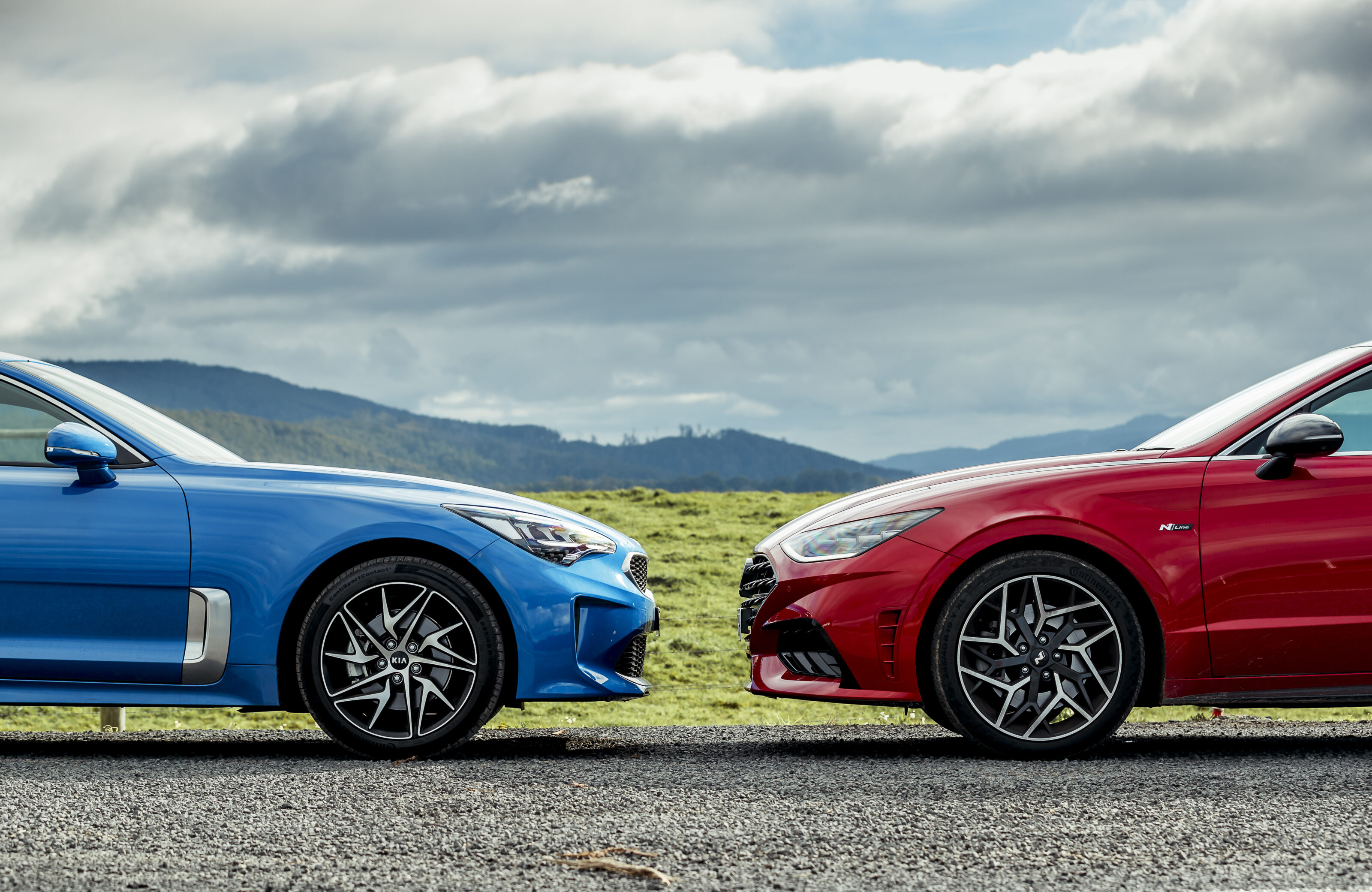My very first job in motoring journalism was almost my last. Back in 1998, the title I worked for took a bunch of the newest and freshest performance cars and set up an informal race from sea to sea across the UK. The star of the show was the Nissan Skyline R33 GT-R, marking the very first time a GT-R had been officially imported to those shores. Cars were allotted to drivers by drawing straws. The short straw, in effect the joke car, was a Hyundai Pony. The GT-R was billed as ‘the car that almost drives itself’ due to it being packed with so much processing power which, by today’s standards is probably on a par with my garage door opener. I managed to prove otherwise by driving it into an Armco barrier, but that’s another story for another day.
If you’d have told me then that one day I’d be driving a Hyundai sedan with more power than the jaw-dropping Godzilla, I’d probably have laughed in your face, but here it is, in the form of the latest Sonata N Line.
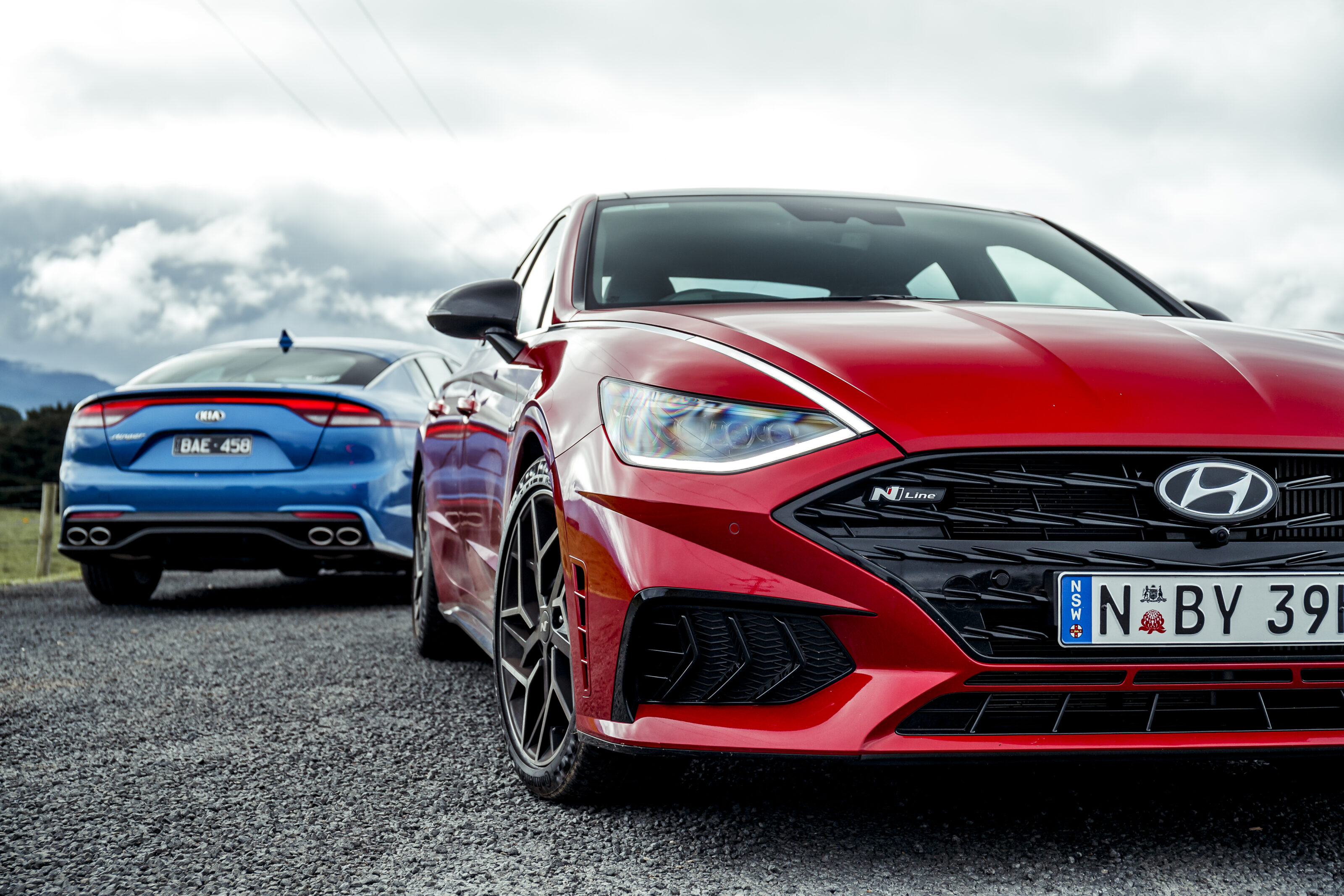
I also laughed when asked if we should include the Sonata N Line in our Hot Source section. Hell no, what do we want that in there for? The more I considered it, the more I wondered whether perhaps the joke was on me. Here was a car that was affordably priced, stacked to the gills with gear but which would conceivably dip into the fives to 100km/h on a decent strip. Yes, its 213kW drove through the front wheels, but that same 213kW is some 7kW more than the old Japanese ‘gentleman’s agreement’ power limit. So this Sonata is packing more grunt than hero cars from our youth such as the Honda NSX, Toyota Supra, Subaru Impreza 22B and, yes, the Nissan Skyline GT-R. Letters about the GT-R’s real power output to the usual address, please.
So, yes, I reckon it does deserve a place in Hot Source. Finding a rival to put up against the $50,990 Sonata is fairly straightforward, too. None of the German brands deliver much in the way of interest, or indeed kilowatts at this price point… 110kW worth of Audi A4 35 TFSI anyone? Thought not. Instead, we turn to the 182kW, $50,050 Kia Stinger 200S which, while not getting particularly close to the Sonata’s punchy power-to-weight ratio, offers up an intriguing Korean front- versus rear-drive face-off.
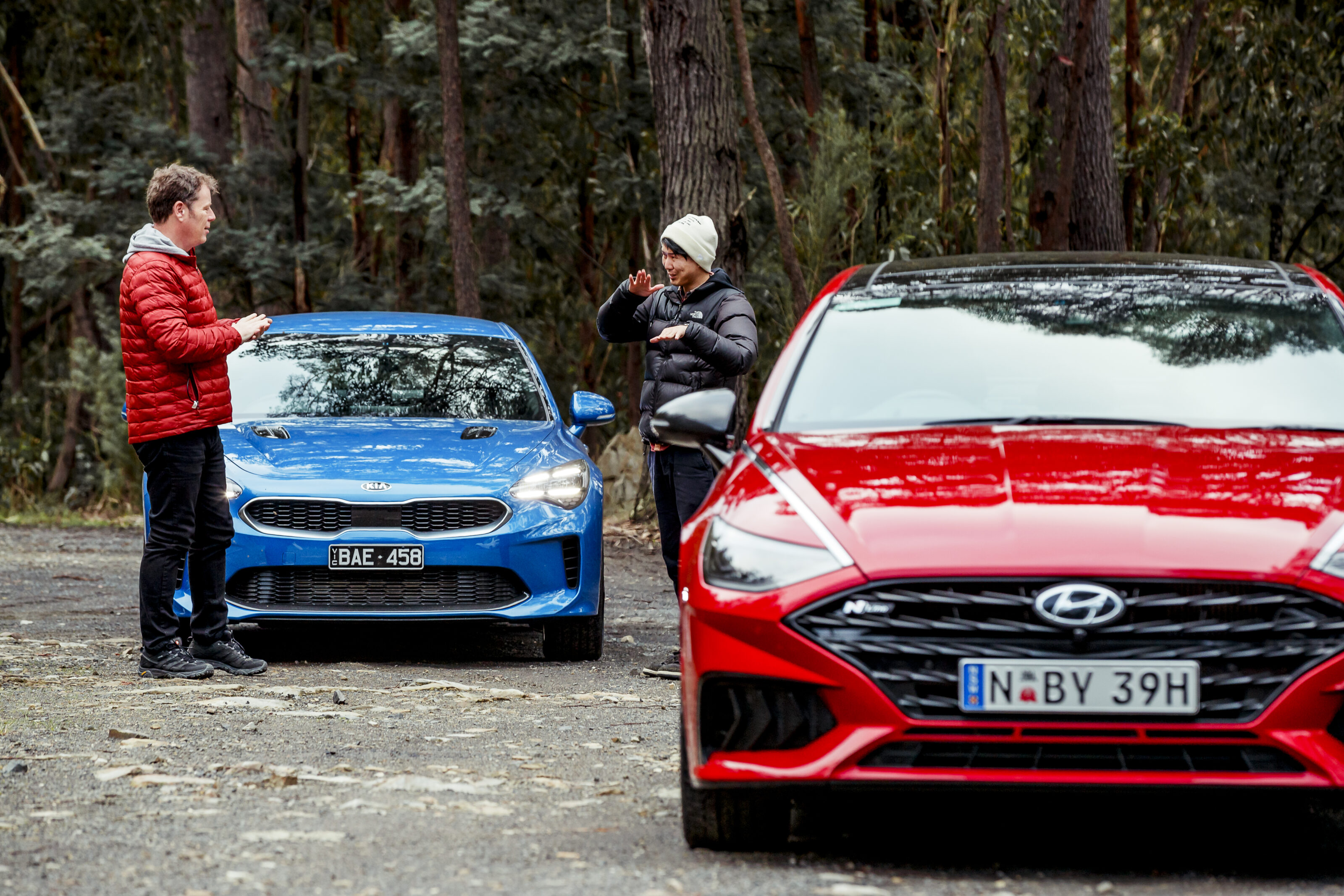
The Sonata is a big car. It takes up more space on the road than a BMW 750i V12 from the Nineties, yet weighs a mere 1636kg. At this point, I usually mention something along the lines that aesthetics are subjective, but in this instance I’m prepared to park that argument. While the overall stance and line of the Sonata are deftly executed, the details are overwhelming. Whether it’s the goofy scatter of fake vents, the bizarre daytime running lights that arc up and round through a chrome-effect detail line or the rear end that is one horizontal element after another all sitting atop a non-functional diffuser, it’s as if Hyundai didn’t know where to stop.
By contrast, the Stinger looks an exercise in restraint and maturity, although it doesn’t sit on its wheels quite as smartly as the Sonata, its slightly porcine flanks and oddly offset overhangs making it look more conservative and, yes, a little older. The plumped up haunches and lengthy dash-to-axle proportions scream rear-drive though, which helps underscore its increasingly rare key dynamic attribute. Photographer Dewar proclaims the Kia an easy car to photograph, unlike the Sonata which affects a weird barbel-faced bottom-feeder look from certain angles. It’s certainly happiest in profile.
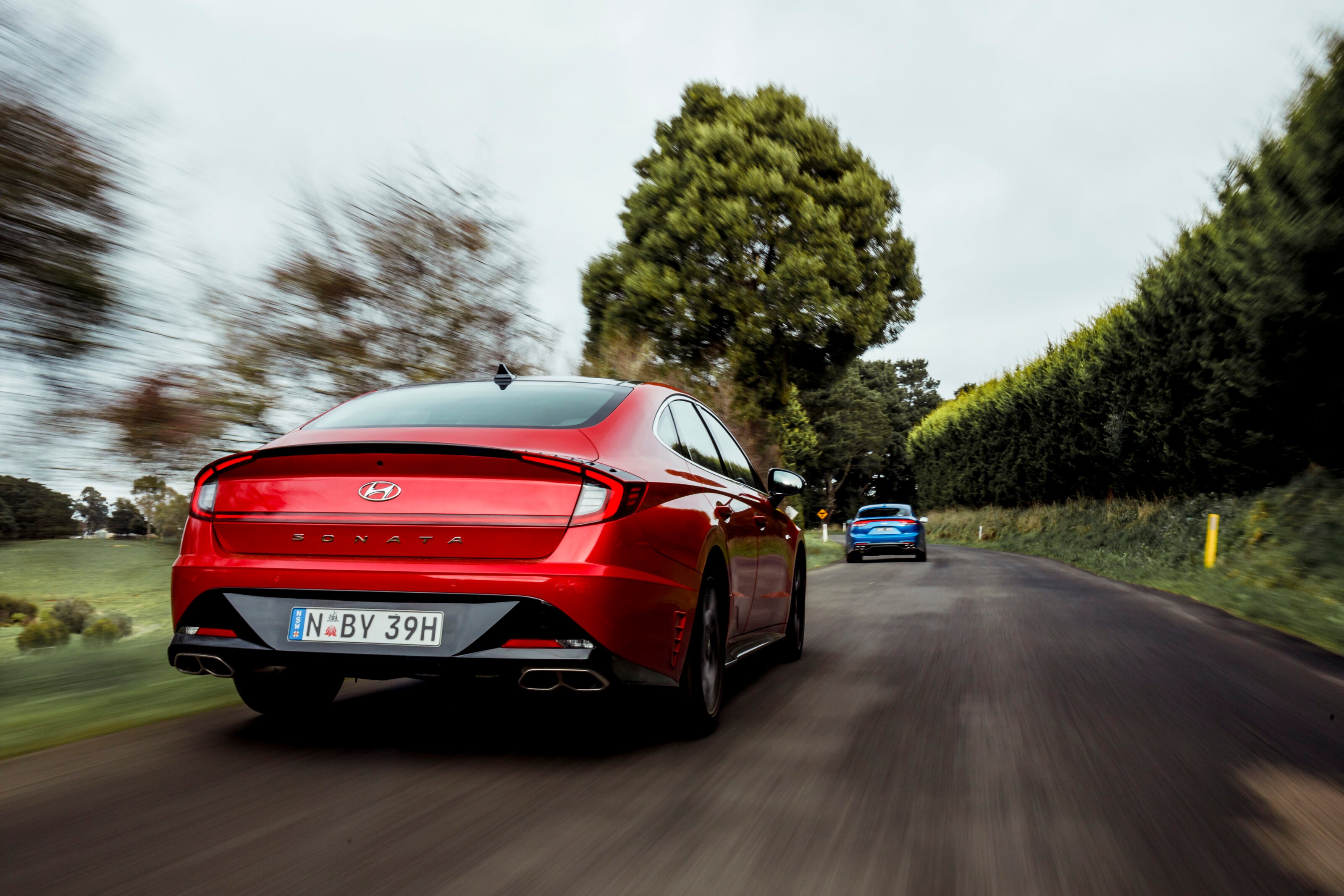
The N Line is the only Sonata model that Hyundai offers and there’s so much gear in it, it’s hard to know where to start. It has everything you could reasonably expect at this price point and ladles in extras like the TFT digital clocks that switch to rear-view cameras when you indicate, heated rear seats, 12-speaker Bose stereo, 12-way adjustable driver’s seat, power blinds in the rear, Nappa Leather and suede heated and cooled front chairs, head-up display and so on. When you consider this versus the price point of the new Golf GTI, it’s unlikely that you’ll ever feel short-changed here.
Given the standard inclusions, Hyundai could probably be excused for making certain economies beneath the bonnet, but the 2.5-litre direct injection lump certainly fronts up with some compelling numbers. It drives through an eight-speed dual-clutch and makes its peak power at 5800rpm, with 422Nm arriving at 1650rpm and not getting its coat until 4000rpm. It’s undeniably effective. In anything other than bone-dry conditions there’s enough juice being applied to the 245/40 R19 front Continental Premium Contacts to send the front axle into some entirely furious tramp off the line.
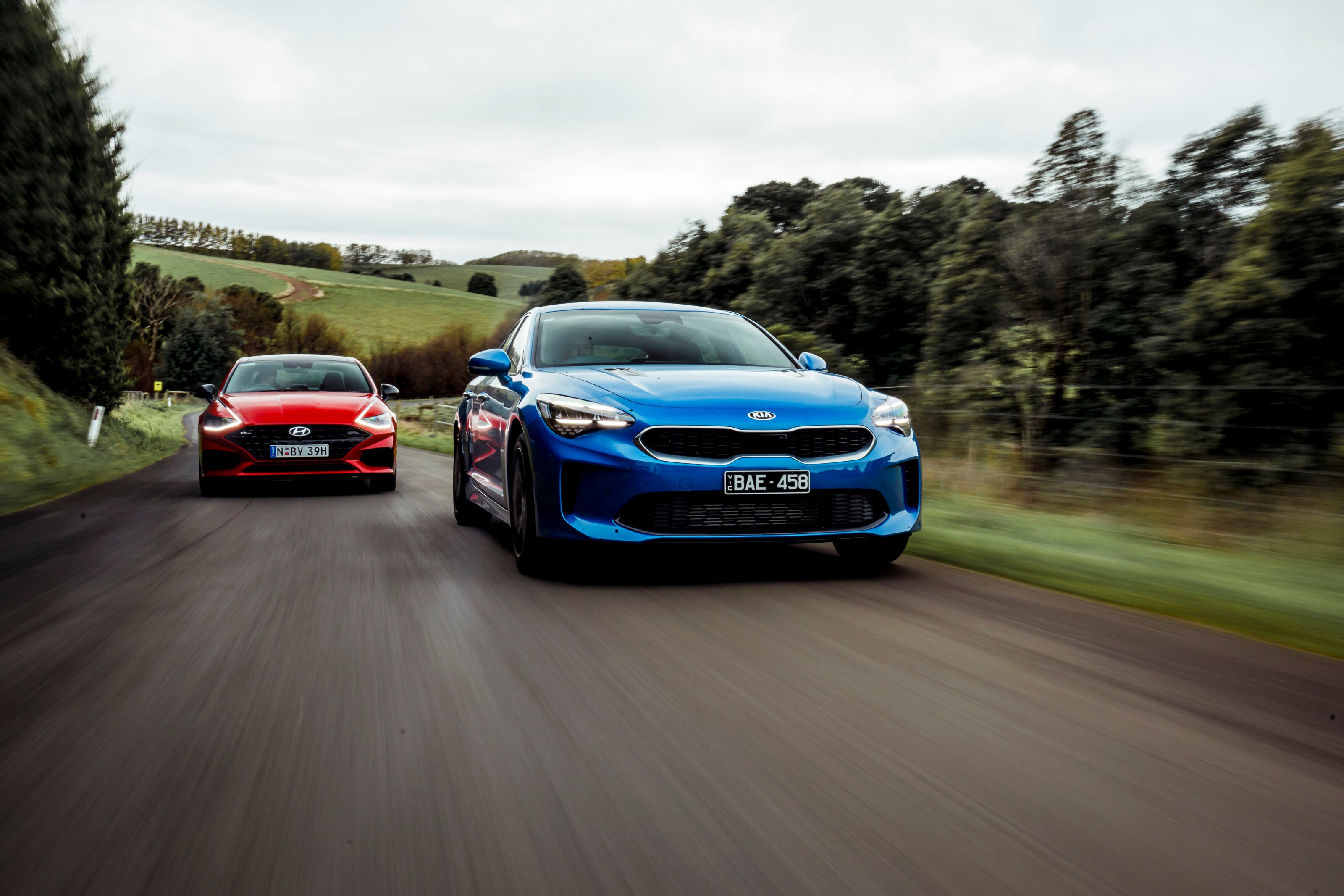
The angriest Sport+ drive mode shucks off much of the moderating influence of traction control, which only makes things worse, so Sport is a better mode for road driving, helping to quell torque steer admirably. With launch control enabled, the Sonata is able to hit 100km/h in a very reasonable 6.0 seconds on a non-prepared surface. While you do get a slightly elastic but wonderfully malleable power delivery, the engine note isn’t any great advertisement for internal combustion. There’s an almost diesel-like toppy clatter to the two-stage variable-induction G4KP 2.5-litre, which the Sonata shares (in certain markets) with the latest Kia Sorento and Hyundai Santa Fe SUVs. Even an Active Sound Design symposer and noise cancellation can’t rescue it from its acoustic shortcomings.
Not that you have to work the engine too hard to keep pace with the Stinger. We’re talking a power-to-weight ratio of 130.2kW/tonne for the Sonata versus 103.6kW/tonne for the Kia, or more than 21 per cent greater in the Sonata’s favour. The difference off the mark is less than that, thanks to the Kia’s traction advantage, with the 200S recording a 0-100km/h time of 7.1 seconds.
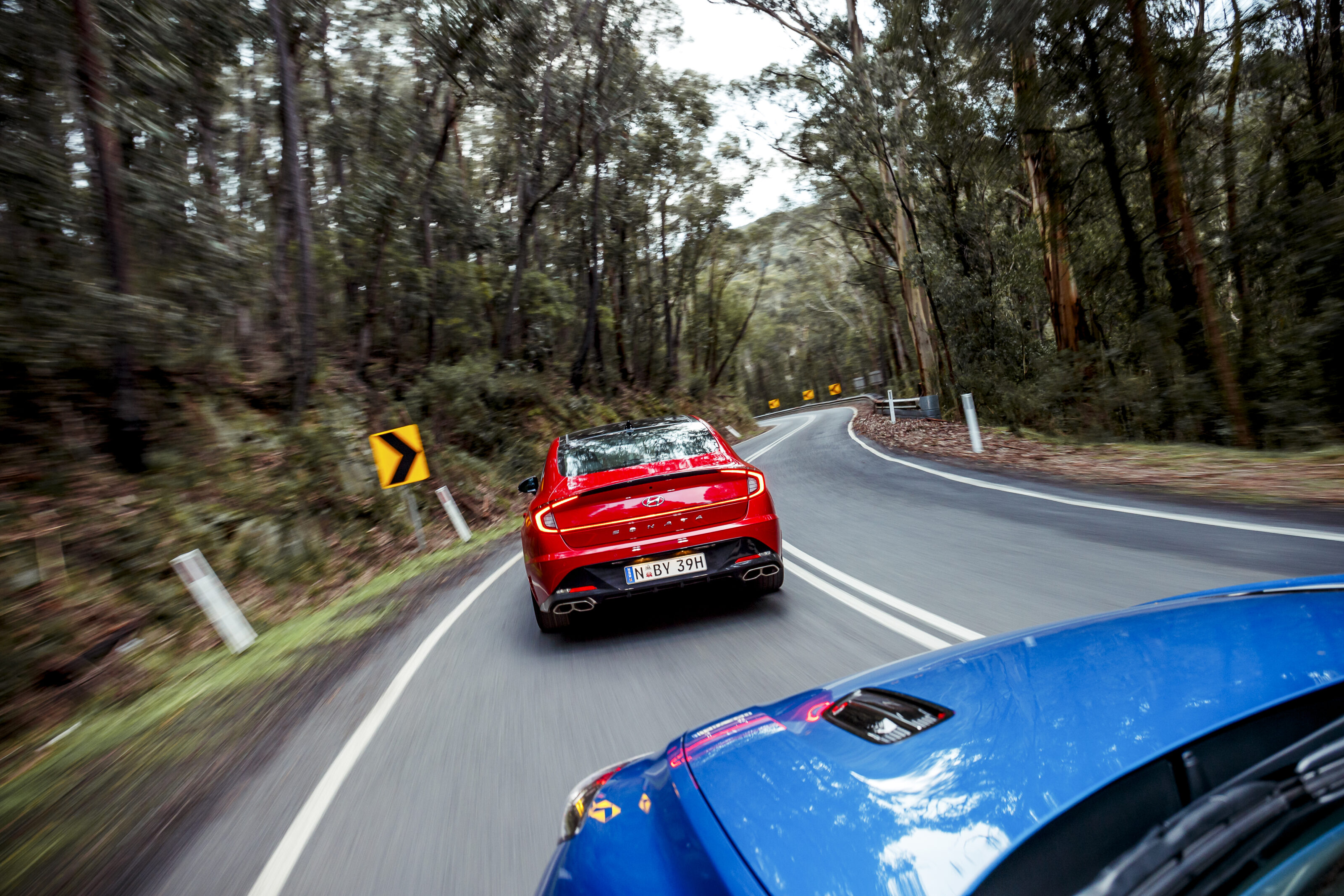
We headed onto the closed road between Noojee and Mt Baw Baw for our drive assessment, road crews working to re-open this section following the recent storms. Only on the very tightest corners does the Sonata struggle to put down its power, with most bends seeing its crisper dual-clutch and superior PWR take lengths out of the Kia in the sprint to the next braking zone. It’s markedly faster and feels livelier too, with its column-mounted electric steering offering keen turn-in and decent accuracy. It never feels particularly organic in its response but you soon learn to key into it. The transmission is slick and rapid, with the N Power Shift function keeping the throttle open wider and longer during upshifts for a little extra drama when engaging the next gear.
The brake pedal is reassuring in its calibration, working on 345mm front discs, but a spirited drive on a twisty section saw the pedal soften a little after a couple of kilometres out and back. We discover one particularly challenging corner with surface ripples in the braking zone and then a noticeable bump when powering out. The Sonata’s slightly terse suspension tune never has the suppleness to deal with the high-frequency ripples on the way in, leading to understeer which is easily managed, but the big hit on the way out creates no particular dramas.
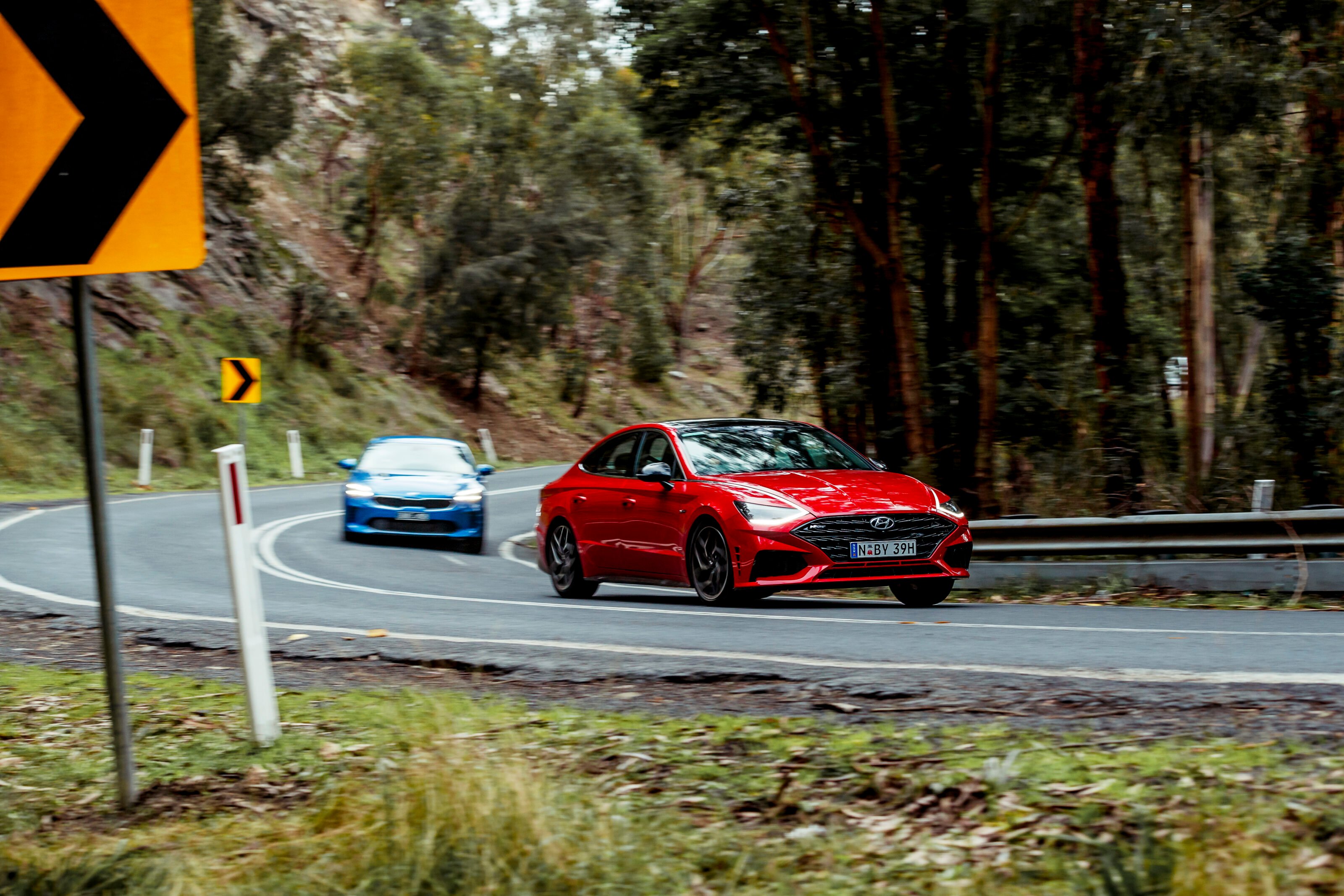
Jump into the Stinger and it’s a very different story. Its softer front damping manages to steamroller the ripples flat, but as soon as you begin to progress the throttle on the exit of the right-hander, the car is tipped into incipient oversteer by the bump and the stability control takes a hard bite at the nearside front brake disc. So fierce is this application to counter the yaw response that after a couple of runs through the corner, the Stinger’s pads smell extremely toasty. Dial the systems out and you’ll need quick and accurate hands.
There’s something reassuring about the Kia’s benign roll response and the way that you can shift its masses about predictably. There’s no LSD or variable-rate steering as in ritzier Stingers but throttle calibration is a little more measured than the Sonata. The Stinger’s eight-speed torque-converter automatic, while not so responsive to manual downchange requests as the Hyundai’s dual-clutcher, slurs through gears more cleanly, shocking the drivetrain less. The Stinger rides on a more focused tyre than the Hyundai, but puts less rubber to the road, the 225/45 R 18 Continental SportContact 5s offering up a contact patch that’s 12.3 per cent smaller. This coupled with the Stinger’s additional 120kg of heft means that it’s easy to exceed the Kia’s limits of front-end grip if you’re trying to keep pace with a well-driven Sonata.

For the most part, the Stinger feels a more amenable thing to pedal at anything up to eight-tenths, which makes it a great car for ‘normal’ sporty road driving. This raises a question and it’s one that’s absolutely key to this comparison. Remember that we’re comparing a front- and a rear-drive car here. Is the Stinger a good enough rear-drive car to accept its other shortcomings versus the Sonata? Having run a Stinger V6 long termer, my view of the platform gibes with that of Scotty Newman, who’s waving goodbye to his Stinger V6 in the Garage. It’s a good chassis, but not a great one. If you really want to exploit the benefits of rear-drive, it probably wouldn’t be either of ours’ first port of call.
In this company it’s also starting to feel a little dated, despite a 2021 refresh, which sees the Stinger receive updates to its suite of safety systems, a larger but occasionally fritzy infotainment system with Apple CarPlay and Android Auto connectivity, full width rear lights, crisper-looking front lamps, restyled wheel designs and some higher quality interior touch points. It’s undoubtedly a simpler car inside than the Sonata and, for some, that’s no bad thing. Live with a Stinger and you’ll come to the conclusion that the rear-drive chassis isn’t the big draw. Its sheer ease of use is what makes the Kia such an endearing proposition.
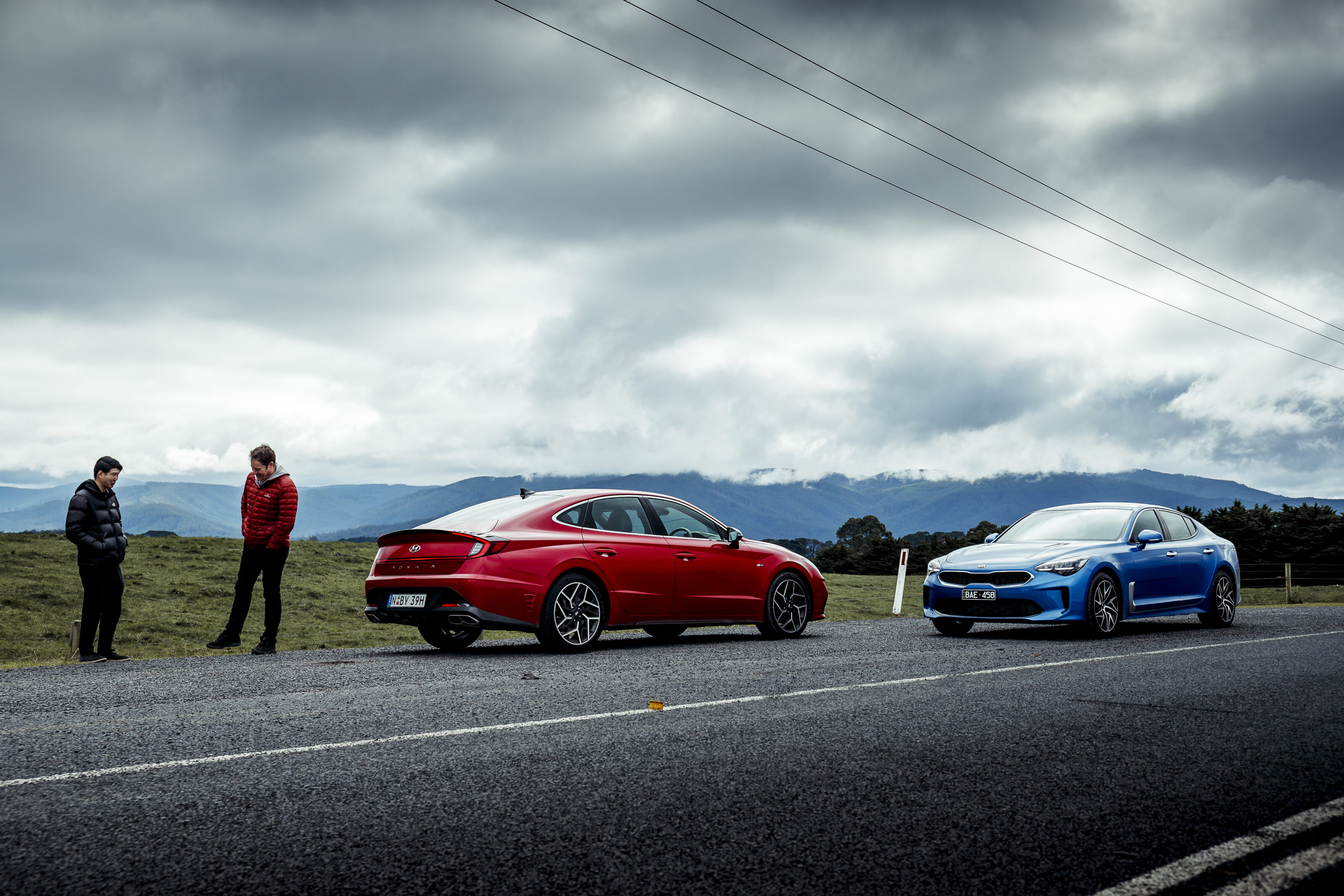
Like every Stinger before it, this 200S is plagued by a near-constant hatch rattle when encountering imperfections in the road surface, fixed by fitting a revised rubber bump stop inside the boot. You’ll also want to switch off the overly intrusive lane-departure warning, which entails a trawl through the touchscreen on every journey. That also gets rather old quickly. For the most part, the interior ergonomics of the Stinger still stand up very well, even if it is missing gear like a wireless phone charger, seat heaters or a head-up display.
Thankfully Kia has fixed what was one of the Stinger’s most frustrating dynamic oversights, namely that when you flick the ’box into manual mode while in Sport or Sport+, it’ll hold that gear until instructed otherwise. Previously, the Stinger would allow a few seconds in manual before snicking back into drive, which was hopeless as it would often click out of, say, pre-selected third gear at corner entry and straight up into seventh, leaving you with no meaningful throttle authority at apex. It’ll still do that in Comfort mode which is no great issue, but is thankfully a bit cleverer in the angrier settings.
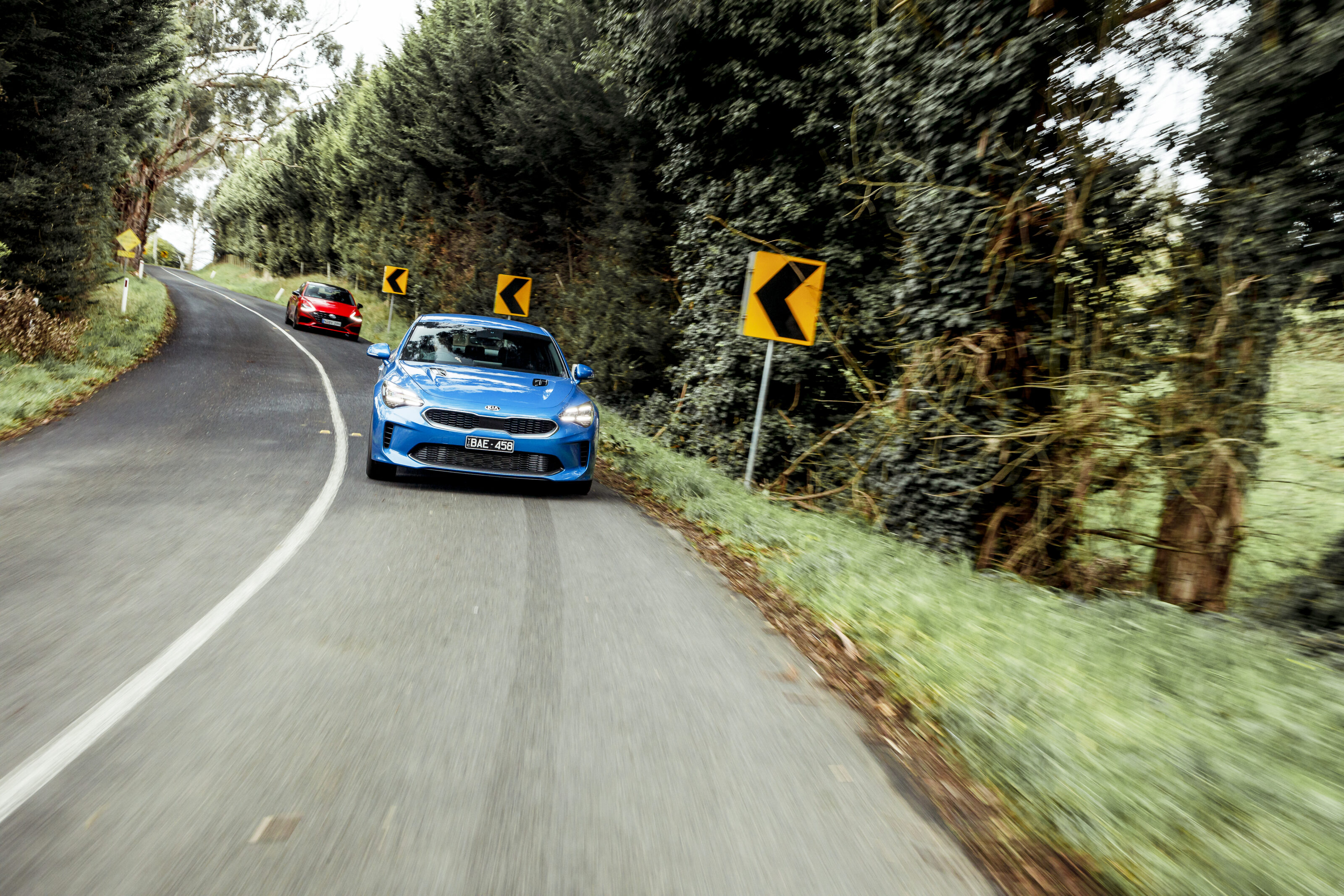
The Sonata’s slightly dorky button-initiated transmission is part of a sea of piano black that soon looks a little matte sebaceous after use, and the virtual clocks, which switch from a bright metal look to carbon-fibre effect in sportier modes, always raised a chuckle. You’ll find yourself switching into Sport at night whether you need it or not, merely to dim the gauche glare of the standard dials. Strangely, the more modern infotainment system in the Sonata was far flakier in recognising and retaining smartphone mirroring than the Kia’s, but the inbuilt navigation system is a couple of steps more sophisticated than Kia’s serviceable effort. The ‘Sounds of Nature’ ambient sound package common to both cars is a bit of a head scratcher, the ‘calming’ foosteps in the snow sounding more like a stalker outside your ski chalet.
The Sonata also features rear-vision cameras that temporarily replace the speedo and tacho with a view down the flank of the car when, respectively, the left or right indicators are operated. The irony is that your peepers will probably only alight on these displays if you’re not using your mirrors properly.
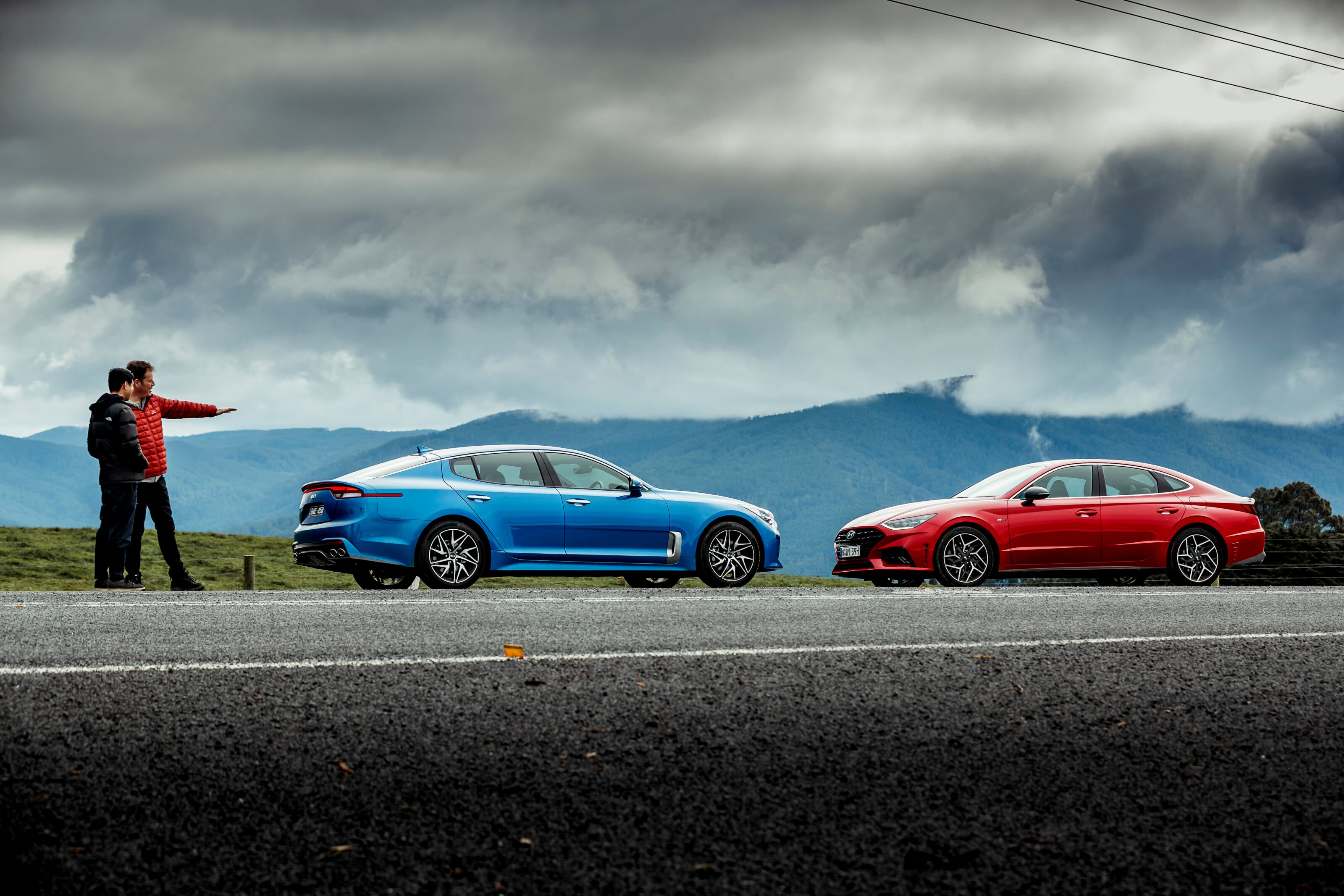
This highlights the issue with the Sonata N Line. There’s precious little subtlety to it. Curiously for a company which is on such a high as Hyundai, this manifests as underconfidence; that the only way for this car to be taken seriously would be to inject it with an excess of almost everything, when dialling things back a few degrees would have resulted in a better end product.
The fake vents, the carbon-fibre virtual dials, the nibbly suspension tune, the vortex generators on the rear light clusters: it’s all just a bit much. It’s hard to complain about the sheer amount of content that Hyundai is packaging into the Sonata N Line for $50K, but there are times when a cogent argument can be made for something that feels simpler, friendlier and purer.
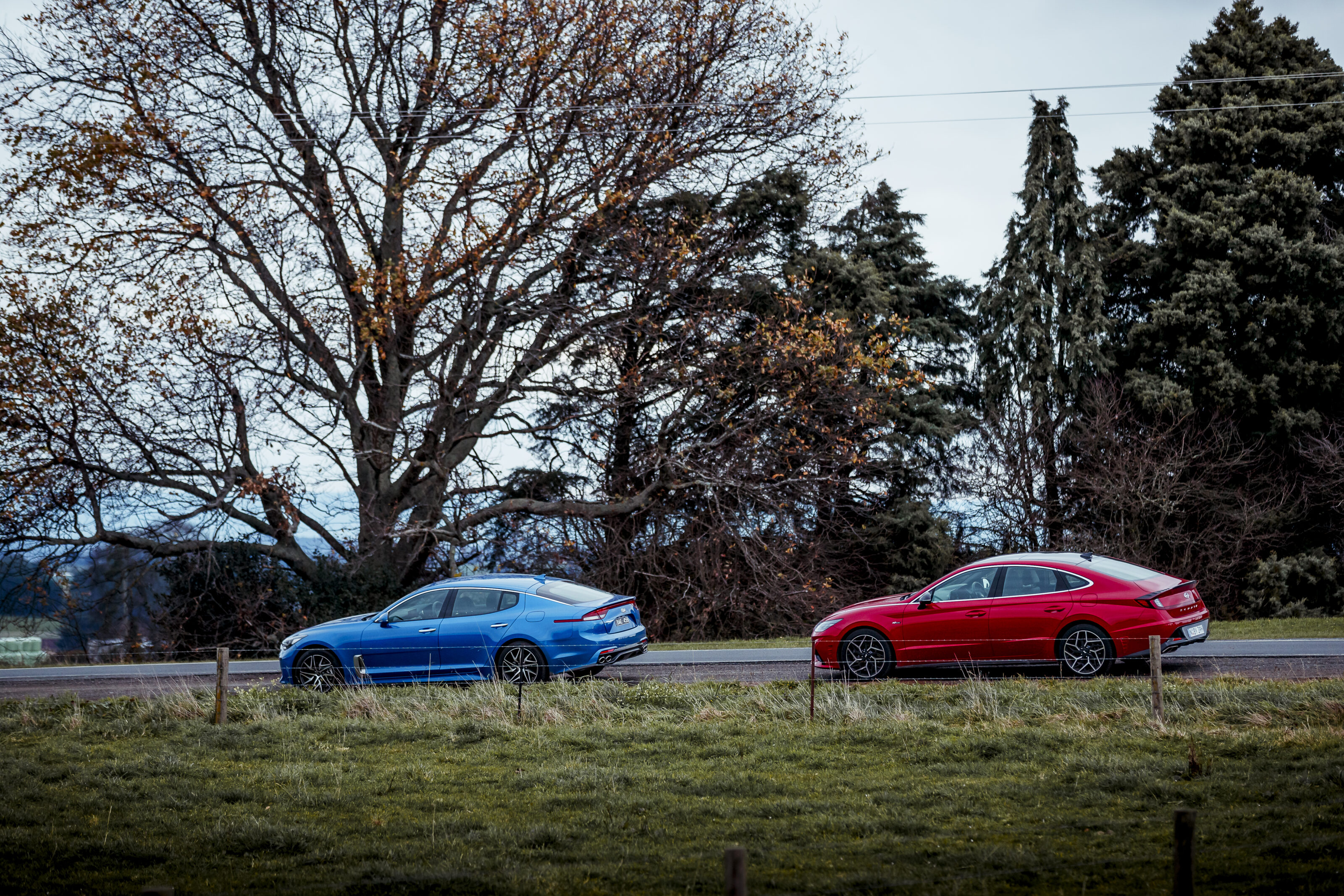
That car could well be the Kia Stinger 200S. Where the Sonata is over-wrought, the Stinger is confidently understated. As a performance car, it’ll be left for dead by the sheer muscle of the Hyundai, but there’s a complementary feel to many of its controls that makes driving the Stinger at briskish road speeds surprisingly satisfying. Up the ante and it gets a little ragged. The same can be said for the Sonata but its limits are higher and therefore less likely to be breached on the public highway.
So which to choose? There are solid arguments for both. If you’ve grown out of hot hatches and need a family car that can still raise a smile, there’s much to be said for the Sonata N Line. Yes, some of its execution is a bit on the nose, but it’s a fundamentally capable thing that’s decent value. If it weren’t for the excesses of its styling, it’d make a great Q-car, as there’s something satisfying about leaving respectable performance cars for dead in a Hyundai Sonata. It’s lavishly equipped and nicely finished but does it deserve a nod of respect in the company of today’s performance sedans? By the numbers, most certainly.
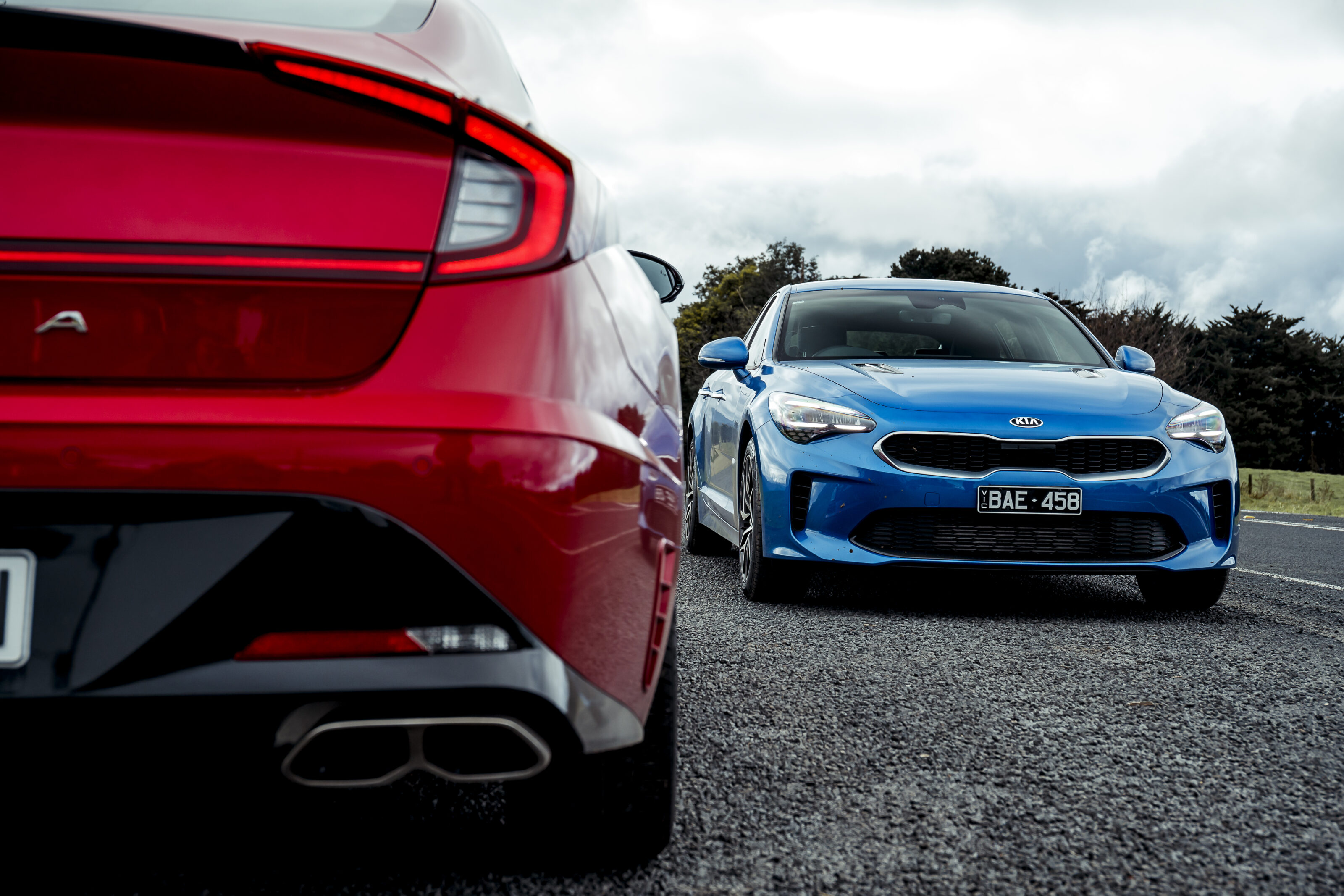
Look deeper and the warp and weft of its argument start to fray. It’s a car that unravels the more you ask of it, yet the flinty brittleness of its ride remains even when you’ve mentally dialled back. The Stinger, on the other hand, can always lean on its benign basic fluidity, helped in this instance by a little more tyre sidewall and some more conciliatory damping.
There’s the kernel of an excellent car in the Sonata N Line but the execution is, at present, a little unresolved. The Stinger is the opposite, a car that makes a decent fist of fairly uninspiring ingredients and these two contrive to meet somewhere in the middle. Right now I’d take the Stinger. It feels more comfortable in its own skin and more rewarding to flow along a challenging road due to a certain measured assurance in the feedback loops of controls and responses. Such is the inherent promise of the Hyundai that its day will surely come. Today, however, is not that day.
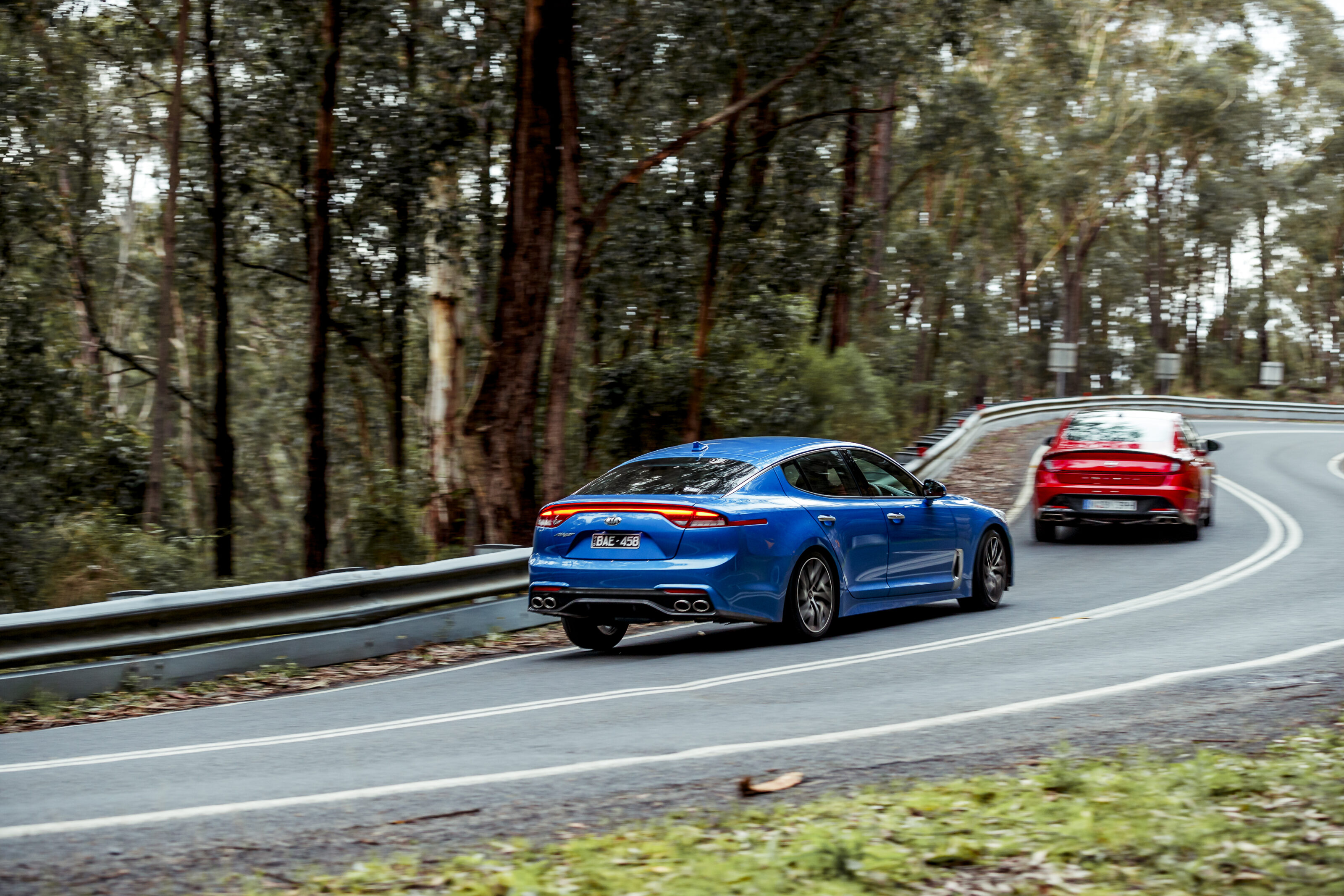
2021 Hyundai Sonata N Line specs
| Body | 4-door, 5-seat sedan |
|---|---|
| Drive | Front-wheel |
| Engine | 2497cc inline-4cyl, DOHC, 16v, turbo |
| Bore x Stroke | 88.5 x 101.5mm |
| Compression | 10.5:1 |
| Power | 213kW @ 5800rpm |
| Torque | 422Nm @ 1650-4000rpm |
| Power/Weight | 130.2kW/tonne |
| Transmission | 8-speed dual-clutch |
| Weight | 1636kg |
| Suspension | Struts, coil springs, anti-roll bar (f); multi-links, dampers, coil springs, anti-roll bar (r) |
| L/W/H | 4900/1860/1445mm |
| Wheelbase | 2840mm |
| Tracks | 1610/1617mm (f/r) |
| Steering | Electrically assisted rack-and-pinion |
| Brakes | 345mm ventilated discs, 4-piston calipers (f); 325mm solid discs, 2-piston calipers (r) |
| Wheels | 198 x 8.0-inch (f/r) |
| Tyres | 245/40 R19 98Y (f/r) Continental PremiumContact 6 |
| Price | $50,990 |
| Pros | Strong engine; body control; keen VFM; quick transmission; lightness |
| Cons | Overbaked styling; ride firm; poor engine acoustics; power understeer |
| Rating | 7.0/10 |
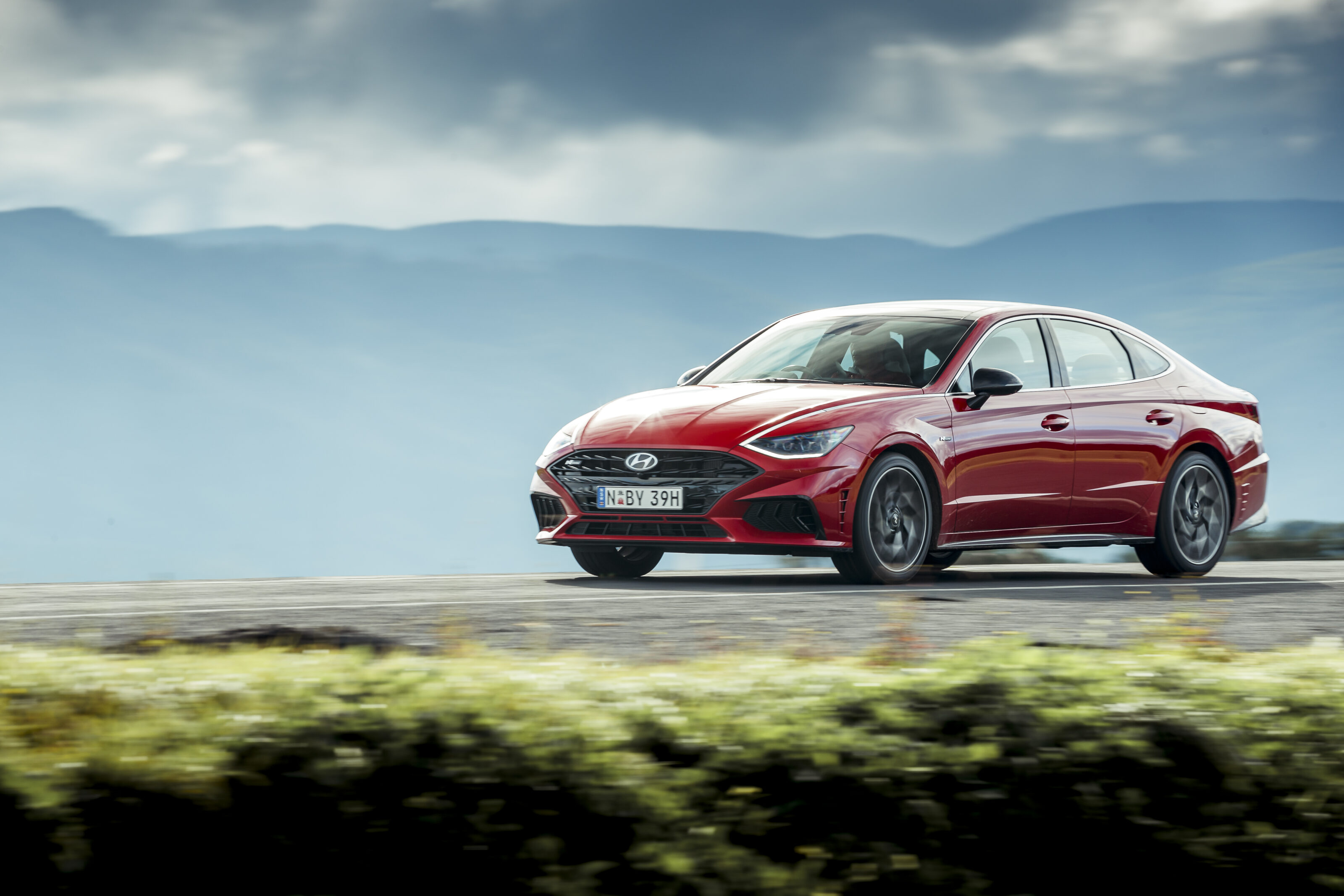
2021 Kia Stinger 200S specs
| Body | 5-door, 5-seat liftback |
|---|---|
| Drive | Rear-wheel |
| Engine | 1998cc inline-4cyl, DOHC, 16v, turbo |
| Bore x Stroke | 86.0 x 86.0mm |
| Compression | 10.0:1 |
| Power | 182kW @ 6200rpm |
| Torque | 353Nm @ 1400-4000rpm |
| Power/Weight | 103.6kW/tonne |
| Transmission | 8-speed automatic |
| Weight | 1756kg |
| Suspension | Struts, coil springs, anti-roll bar (f); multi-links, coil springs, dampers, anti-roll bar (r) |
| L/W/H | 4830/1870/1400mm |
| Wheelbase | 2905mm |
| Tracks | 1596/1647mm (f/r) |
| Steering | Electrically assisted rack-and-pinion |
| Brakes | 320mm ventilated discs, 4-piston calipers (f); 314mm solid discs, two-piston calipers (r) |
| Wheels | 18 x 8.0-inch (f/r) |
| Tyres | 225/45 R18 95Y (f/r) Continental SportContact 5 |
| Price | $50,050 |
| Pros | Ride comfort; sweetly willing lump; practicality; improved u2018box |
| Cons | Not that quick; handling scratchy at limit; sheep in wolfu2019s clothing? |
| Rating | 7.0/10 |
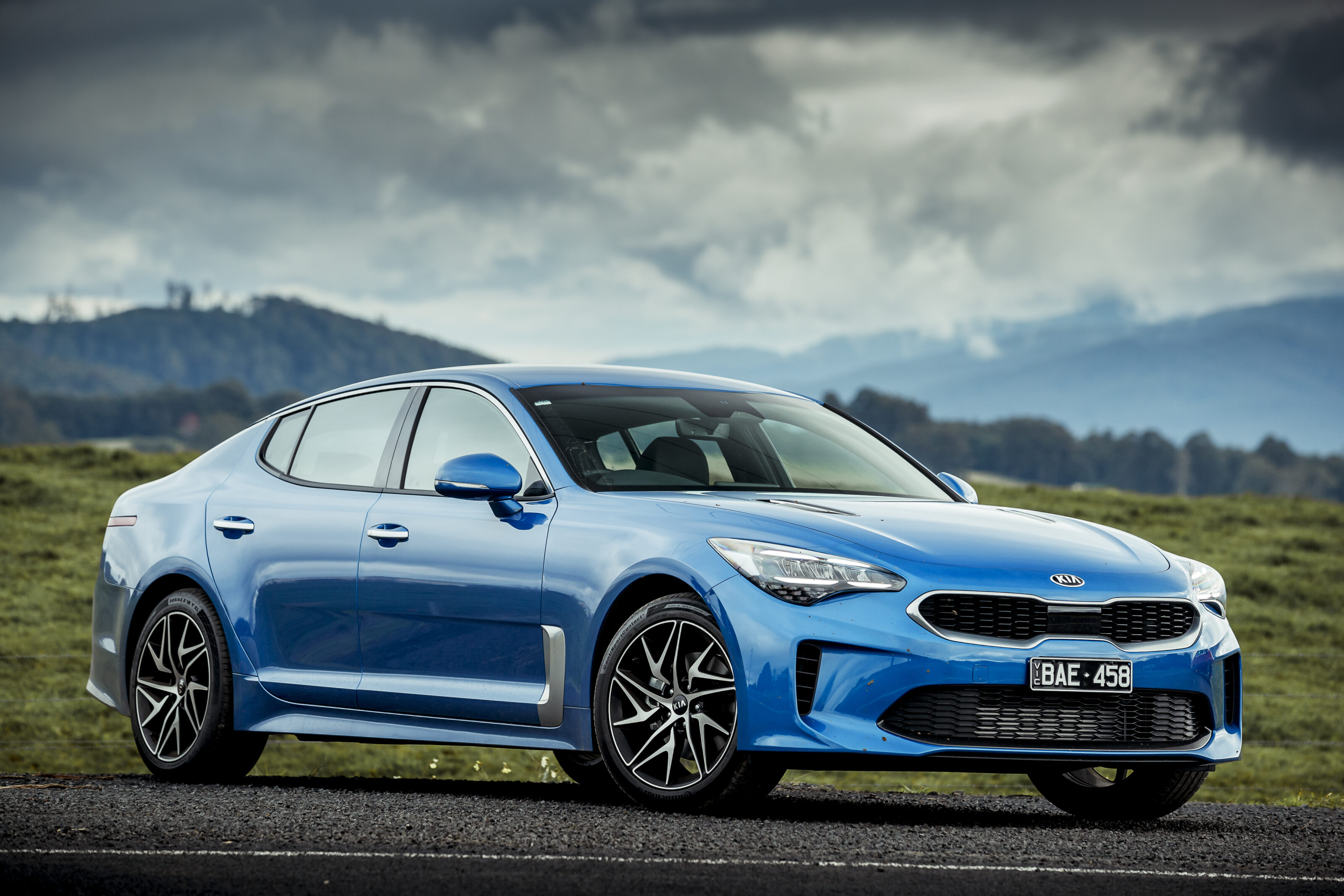
We recommend
-
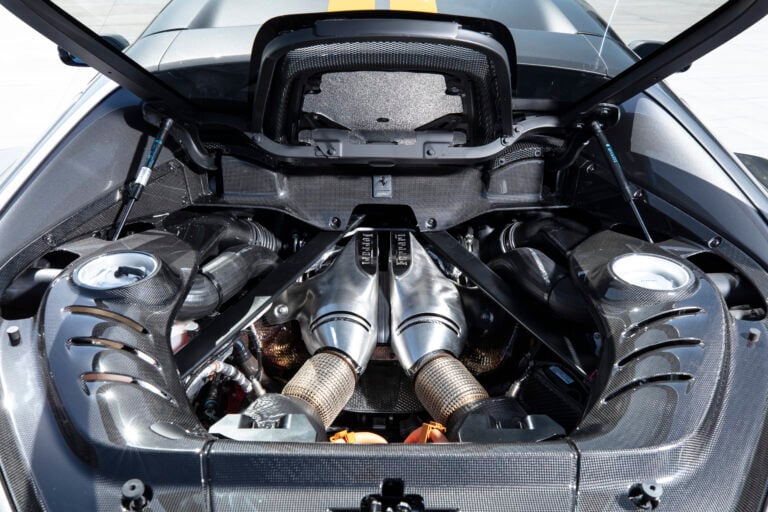 Features
FeaturesWhy McLaren and Ferrari have built 120-degree V6 engines
We explain why two performance powerhouses have thrown their weight behind an engine design that has never been put into mass production
-
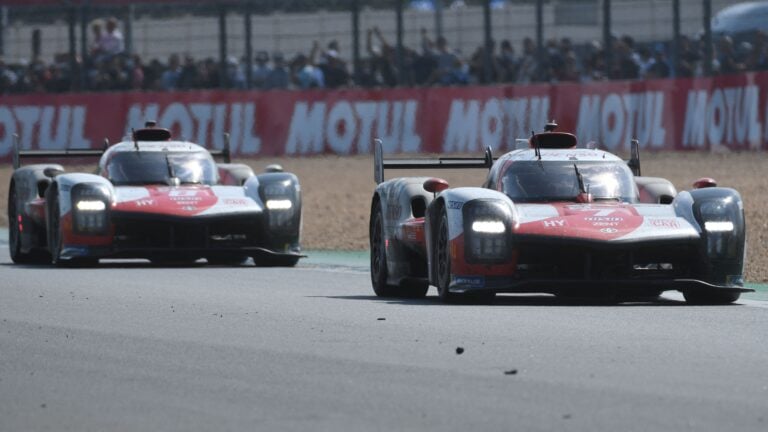 Features
FeaturesHere's every manufacturer looking to race at Le Mans
From Ferrari to Cadillac, the grids at La Sarthe is going to get very crowded in the coming years
-
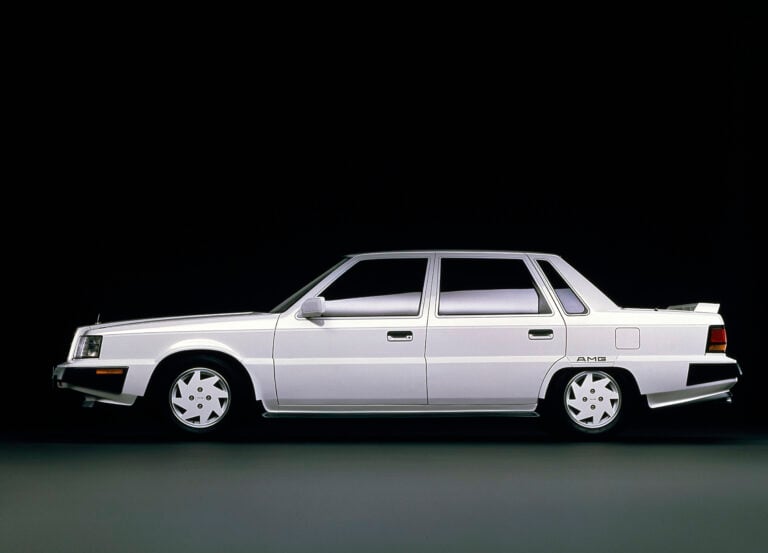 Features
FeaturesThe Japanese AMGs you’ve never heard of
Remember when both Honda and Mitsubishi paired up with AMG? We do!


